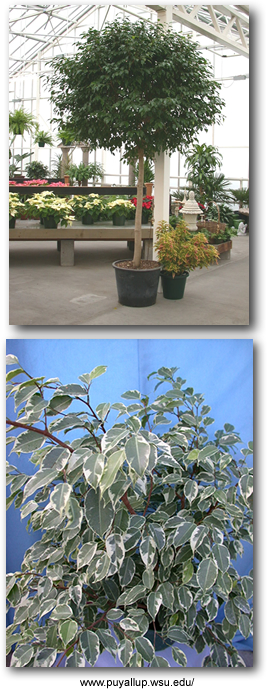Weeping Fig (Ficus benjamina)
Also known as Weeping Ficus, Benjamin Tree, Java Fig
⚠️ Allergy & Sensitivity Information
Non-toxic but allergenic: Can cause IgE-mediated allergic reactions
Possible symptoms: Dermatitis, asthma, rhinitis, conjunctivitis, itching of hands and arms
Caution: Individuals with latex allergies may be particularly sensitive

The Weeping Fig is one of the most popular indoor trees, available in green or variegated forms. While beautiful and air-purifying, they are not the easiest plants to grow due to their sensitivity to environmental changes.
⚡ Sensitivity Alert: These plants can't tolerate drafts and require consistent light intensity and watering regimes. They react to stress by dropping leaves.
🌱 Air Purification: Despite their care challenges, Weeping Figs are excellent air purifiers and create elegant indoor focal points when properly maintained.
Plant Characteristics
📏 Size & Growth
Typical Size: Sold as 3-6 feet potted trees
Indoor Height: Can grow as tall as allowed
Pruning: Easily pruned to suitable height
Form: Elegant with dense, glossy foliage
Trunk: Light gray with arching slender branches
🍃 Ornamental Features
Bark: Smooth, gray appearance
Leaves: Shiny, green, oval-shaped
Varieties: Variegated foliage, wavy leaves available
Training: Stems can be braided, spiraled, twisted
Shapes: Can be trained into hearts and other forms
Understanding Leaf Drop (Most Common Issue)
🚨 Why Weeping Figs Drop Leaves
Weeping Figs seem to react to almost any stress by shedding leaves. This is their most common and frustrating characteristic, but understanding the causes helps prevent it.
💧 Watering Issues
- • Overwatering
- • Underwatering
- • Inconsistent watering
- • Waterlogged soil
🌿 Environmental Stress
- • Cold drafts
- • Low light conditions
- • Temperature fluctuations
- • Dry air
🔄 Change & Care Issues
- • Moving to new location
- • Repotting
- • Lack of nitrogen
- • Sudden environment changes
✅ The Good News
If growth conditions are adequate, the Weeping Fig will adjust to its new location, stop dropping leaves, and healthy new growth will appear. Patience is key!
Detailed Care Instructions
☀️ Light Requirements
Best: Bright indirect or curtain-filtered sunlight
Some Direct Sun: OK if humidity is high
Variegated: Prefer somewhat lower light
Consistency: Maintain stable light levels
🌡️ Temperature
Night: 65-70°F (18-21°C)
Day: 75-85°F (24-29°C)
Preference: Warm temperatures
Avoid: Cold drafts and sudden changes
💧 Watering
Growing Season: Keep soil evenly moist
Winter: Allow slight drying between waterings
Never: Waterlogged or sitting in saucers
Consistency: Regular, predictable schedule
💨 Humidity
Preference: High humidity levels
Methods: Humidity trays, grouping plants
Misting: Can help but avoid overdoing
Air Circulation: Good but no drafts
🌱 Fertilizing
Frequency: Every month or two during growing season
Type: Liquid fertilizer for healthy plants
Winter: Reduce or stop fertilizing
Nitrogen: Important to prevent leaf drop
🧼 Maintenance
Leaf Cleaning: Wash with plain warm water occasionally
Benefits: Helps leaves "breathe" and improves appearance
Pruning: Can be shaped as needed, tolerates hard pruning
Repotting: Late winter/early spring when crowded
Common Problems & Pest Management
🦗 Common Pests
Frequent Pests:
- • Spider mites: Very common, check regularly
- • Scale insects: Hard/soft scales on stems and leaves
- • Mealybugs: White, cotton-like insects
Occasional Pests:
- • Aphids: Small, soft-bodied insects
- • Thrips: Tiny, slender insects
- • Prevention: Regular leaf washing and inspection
🚨 Disease Issues
Root Rot: Most common disease problem indoors
Causes: Soil mix that doesn't drain quickly or overly frequent watering
Prevention: Well-draining soil and proper watering schedule
Propagation & Repotting
🌱 Propagation Methods
Air Layering
Can be done at any season. Best method for larger plants.
Cuttings
Best taken in summer when plant is actively growing.
🪴 Repotting Guide
Tolerance: Can tolerate being slightly root bound
Signs to repot: Small new leaves, slowed growth
Timing: Late winter or early spring
Soil: General-purpose potting soil
After pruning: Reduce watering for severely pruned plants
Popular Cultivars
'Bushy King'
Small leaves with narrow yellow edge on dense, compact plant
'Bushy Prince'
Similar to 'Bushy King' but with glossy, deep green leaves
'Daniëlle'
Sturdy, thick, deep green leaves. Pendulous growth. Resistant to leaf drop!
'Judith'
Green leaves with cream-yellow border. Grows well in reduced light, minimal leaf shedding
'Midnight Lady'
Compact, weeping growth with very dark, curly leaves
'Wasana'
Especially suited for bonsai. Shiny green leaves with white, irregular weeping growth
'Golden King'
Narrow irregular band of creamy yellow around each leaf
'Variegata'
Leaves strongly marked with pure white and gray-green. New leaves often pure white
'Too Little'
Miniature ideal for indoor bonsai with tiny recurved glossy leaflets
'Exotica'
Light green leaves with pendulous growth. Each leaf has slight twist adding gracefulness
Success Tips for Weeping Figs
✅ Do's
- • Maintain consistent care routines
- • Choose the right location from the start
- • Provide high humidity
- • Clean leaves regularly
- • Be patient with leaf drop adjustment periods
- • Consider low-maintenance cultivars like 'Daniëlle'
❌ Don'ts
- • Don't move frequently once established
- • Avoid cold drafts and temperature swings
- • Don't overwater or let sit in standing water
- • Avoid inconsistent light conditions
- • Don't panic during initial leaf drop
- • Don't place near heating/cooling vents